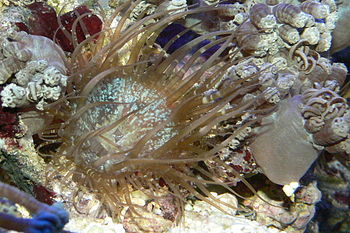 |
| Aiptasia sp. (Photo credit: Wikipedia) |
Aiptasia can reproduce both sexually and asexually. Their asexual reproductive method is known as a pedal laceration. This method involves the growth of daughter clones from the foot of the mother anemone. Pedal laceration allows aiptasia to reproduce very rapidly, and to create multiple new offspring at the same time. Furthermore, many attempts to destroy aiptasia fail. This happens because, even if the mother anemone is manually removed or destroyed, a circle of daughter clones will be left behind.
Chemical approaches to aiptasia removal are also problematic because they can easily destroy other species and ruin the delicate balance required to maintain a vibrant, living reef aquarium. Luckily, humans can borrow some ideas from nature as to how to deal with these prolific anemones; the best solution to an overabundance of aiptasia is to introduce some of their natural predators into the aquarium ecosystem.
There are several potential species to use in this manner. Peppermint shrimp are small cleaner shrimp that naturally consume aiptasia. However, their efficacy is limited by the fact that these shrimp generally prefer other food sources.
Some reef keepers also use a few varieties of butterfly fish, with the Raccoon Butterfly species being the most popular. These fish have also been known to eat other reef inhabitants, including tube worms, corals and other anemones.
The best choice for a predator to introduce is generally Berghia nudibranchs. These animals are mollusks which are commonly called "sea slugs". Berghia nudibranchs are more focused than other potential species on eating aiptasia anemones.
This species of mollusk is small. At the largest, they grow to be one inch in length. When newly hatched, these animals are so tiny they cannot be seen by the unaided human eye. They are often shipped when they are only partially grown, at a size of half an inch or smaller. Berghia nudibranchs at this size are still quite delicate.
Shipping in general causes significant physical stress for aquatic animals. As such, it is highly recommended that you allow your newly arrived Berghia nudibranchs several days at least of time in mason jars to recover their strength. If you do not do so, you risk the mollusks being damaged by high water flows or simply being eaten by the other denizens of your aquarium.
The best practice for nurturing your Berghia nudibranchs in jars before transferring them to the main aquarium is as follows. Place at least six Aiptasia in a large mason jar a week or two before you expect the nudibranchs to arrive. Fill the jar with water from your aquarium. Keep the jar in an enclosed, dark place with a consistent temperature. Allow the newly arrived nudibranchs to remain in the jar for at least two days. When you do transfer them to the aquarium, do so at night.
|

No comments:
Post a Comment